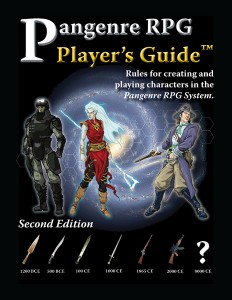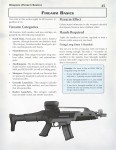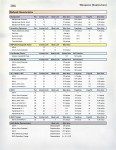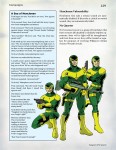Pangenre
Pangenre is a complete role-playing game, published by Pangenre, LLC.
By John D. Powers

Learn more about Pangenre here
Purchase Pangenre here
Find other Pangenre products here
Welcome to the latest Designer’s Diary, a column where designers are given the opportunity to take readers on an in-depth ride through the design and development process of their system, setting, or product. If you’d like to share your product in the Designer’s Diary column, send a message to aaron@roleplayerschronicle.com.
Designer’s Description
The Pangenre RPG is a multi-genre system that emphasizes making things feel more realistic than other games in the same market space while maintaining a high degree of playability. It is designed with mature players in mind, and geared for scenarios that might require more than just breaking down the front door, with skills that run the gamut from combat to liberal arts education. At the core is the character system. Pangenre does not use character levels or classes. Everything is based on skills and abilities.
The Second Edition is currently in Public Beta, with the Player’s Guide and the Magic book released, and it makes a plethora of minor tweaks to the system, but the major changes (mostly simplifications) are as follows:
- Characters are defined by eight abilities, Agility, Dexterity, Charisma, Constitution, Intelligence, Perception, Strength, and Willpower. In 1st Edition, these were based on the Open Game 3-18 concept. In 2nd Edition, we dropped the numeric score and now only use the modifier. (In 1E, you might have a Strength 15 with a +2 bonus, where in 2E, you simply have Strength +2.) This removed an entire layer of unnecessary complexity while still retaining the same in-game effect. It also shaved time off of character generation.
- The 2nd Edition wound system is dramatically simplified from our first iteration, while simultaneously better modeling reality. It is friendlier to players and less predictable in terms of results than 1st Edition.
- We simplified skills substantially as well. Where in 1st Edition, we differentiated between “specializations” and “competencies,” we have rolled those concepts into a single competencies rule. It makes both play and character generation simpler and faster. We also decoupled the concept of skill rank (how good you are) from competencies (focused or specialized training), which means you can learn a wide variety of competencies once you have basic training in a skill (you just aren’t as good at them until you boost your rank).
- You can now have Rank 0 skills, where in 1st Edition, the minimum rank was 1. This changed the Magic book substantially, as we scaled down higher ranked magical effects across the board.
- The 2nd Edition Magic book has more of what was in 1st Edition. More spells, more skills, and more options on how to use them. We hope to add more, especially in the Low Magic skill list, before we switch from BETA to the final release.
Purpose
We designed the Pangenre RPG because we wanted a system that did what we wanted it to do, and we did not find any other commercially available or licensable titles that would work. The final product is intended to give GMs and players a more realistic feel to their characters while keeping the game mechanics as clean and simple as possible. (Games such as RPGs cannot be truly “realistic,” nor should they be, but players should never have to look at a rule and go, “Oh, puh-LEASE!”)
 Influences
Influences
All of us at Pangenre LLC have been gaming for over thirty years, and during that time, we’ve played and tried a large number of game systems, genres, and styles. There is no doubt that anything which has come before has contributed some of its DNA to the Pangenre RPG.
Pangenre was developed on the back of the Open Game SRD. We kept the initiative system, the movement and turn sequence, and the “core mechanic” of “GM sets a DC to beat > roll dice > apply modifiers > compare result.” So if you are familiar with SRD based systems, you already know the basic flow. We also based the magic system on that from the SRD, but it is heavily modified. That being noted, the differences between OGL and Pangenre are vast, and I’ll talk about them more later on.
Another influence was Traveller. The later design work done by Frank Chadwick at GDW (Striker, Azhanti High Lightning, Snapshot) contributed directly to some Pangenre rules, such as how to handle cover and how to model the dynamic between body armor and weapons.
Advanced Squad Leader also provided some concepts like using fully automatic weapons to lay down suppressing fire.
Some rules have come from user feedback, which is always welcomed. We included the idea of “quirks” in one of our 1st Edition supplements based on requests, and that rule is a standard option in the 2nd Edition.
 Research
Research
Research is the cornerstone of designing an RPG. We look up everything. If we get something wrong, we fix it. We do look at other titles for concepts which might improve our system, but it’s rare that we find any. Most of what we get flows in from news sites or Google searches. One of our most recent additions to the rules was some equipment based on a computerized rifle that shoots when it thinks the time is right, which was brought to our attention by an NPR story.
We also do statistical and probability analysis. A good example of that was when we wrote the rules for Kevlar armor. The NIJ Web site had a good article on what Kevlar ratings meant, and what the armor would stop. We compared the numbers from NIJ to the armor and weapon values and deliberately set them so that if armor is rated to stop a bullet, that bullet can still cause wounds, sometimes disabling (getting shot with an AK while in Kevlar IV is still like getting hit by a truck), but they won’t inflict lethal wounds on a non-critical hit.
Occasionally, we do research into other creative works for inspiration, and oh, how I do lament the fact that we can’t afford to license content. I would love to wrap the Pangenre RPG System around things like the anime show, “Psycho-Pass.” We added a couple of off-the-wall low magic skills in our 2nd Edition Magic book that were inspired by anime shows, but copyrights prevent us from mentioning them by name. I am still weighing the merits of adding a “Master of Cutlery” skill as an homage to Hank Azaria.
 Art Direction
Art Direction
Unfortunately, none of our designers are artists. Frederick has a degree in Art History, but he can’t draw much better than Ron can with a Photography degree. And I couldn’t draw a straight line if I was to fall down the side of a building while jabbing a crayon into the wall. So we’ve been making use of what we can find. In Second Edition, we invested in a good bit of good quality clip art and pinched some art from public domain, but we could not afford original commissions. The equipment guide has a lot of line drawings when we could fine images that were good enough to trace (our free Modern Firearms downloads has examples of those). Given our limits, I think we’ve done an acceptable job with the layout. Potential users can peruse the sample pages on OneBookshelf and on our Facebook page.
Gaming Experience
The Pangenre RPG System is designed with experienced role-players in mind and to give GMs flexibility to create different experiences for their players. It uses 2d10 for most dice rolls, taking advantage of the bell curve to keep other scaling elements such as skill ranks in balance.
The skill system has two tiers. At the high level, there are the skills themselves. Skills have ranks that run from 0 to a potentially unlimited level (with practicality and diminishing returns restraining min-maxing). At the second tier are Competencies, which either allow you to learn specialized knowledge within a skill or to get some kind of bonus when using them. This system allows GMs to easily add new skills and competencies simply by plugging them in. For example, Martial Arts skill encompasses all kinds of melee combat, but is greatly enhanced by specializing in different style competencies such as unarmed combat or fencing.
Combat is drastically different from the SRD and has some marked differences from the other games we have seen. Characters do not have hit points. Instead, if you get hit, you may be wounded. Wounds run the gamut from those which do not affect your game performance (but make subsequent wounds more dangerous) to serious wounds which can potentially make you combat ineffective, to critical and mortal wounds which can either disable or kill you outright. The system is balanced in favor of players, making it uncommon to kill a PC outright, but charging a machine-gun in the buff is going to yield the expected results.
When everything comes together, Pangenre flows like D&D 3.5, but handles modern gun combat superbly and integrates it with magical effects seamlessly. I think we do modern combat better than any other system on the market, with a great balance between playability and realism. If I didn’t, we’d play another game.
Comparison
Pangenre is a universal RPG system with a focus on realism, or at least reasonability. It cannot be fairly compared to more abstract systems such as Fate or Savage Worlds. The closest thing to it, of which we are aware, is GURPS, except that Pangenre relies less on abstract character powers and places a greater emphasis on realistic skills.
Compared to the Open Game SRD on which it was based, Pangenre keeps the streamlined gameplay and relatively quick flow of turns and pairs it with a totally redesigned character and combat system. We did take pains to make it possible to play Open-Game “style” campaigns, but the two systems are not interoperable without substantial conversion (the GM’s Guide has a chapter on how to convert Open Game characters to Pangenre, but it’s not a 100% guaranteed proposition that everything will transfer identically).
Of course, even though we can handle almost any game scenario, there is one thing we do less well than other systems, and that is superheroism. Pangenre is intended to feel realistic, and it is difficult to reconcile both of those ideas. We did include a system in the Pangenre RPG Magic guide to enable the creation of superhero characters, and it works, but I think that if players and GMs want a truly Marvel-ous experience, they should stick with one of the more specialized superhero games. But for everything else we’ve tried, Pangenre has come through. As a testament to the flexibility of the system, we have run the following game styles during our development without difficulty:
- Open-Game style high fantasy.
- Renaissance Venice, with low fantasy.
- Victorian steampunk.
- Western-horror.
- Modern horror.
- Post-apocalypse Las Vegas.
- Near-future science-fiction.
- Far-future science-fiction.
Development Process
First, a little history.
Pangenre grew from a simple concept. I was writing a series of science-fiction scripts when I noticed that the concept might make for a good RPG scenario. Then I thought, why not pair up the two ideas and write a narrative story around a game scenario (and try to sell it). I pitched the idea to Ron Moore, another of our founders, and he agreed. We decided to start developing IP content for publication. Our next step was to bring Frederick Noble, our third partner, into the fold. He was amenable, and Pangenre, LLC, was born.
For us all to work together, we needed a common game system. We first looked at existing systems that we might be able to license. Our test was straightforward. We needed to be able to create the characters we wanted within the game system. We wanted something with a wide user base, but that was secondary. Ultimately, we found NO licensable systems that did what we wanted.
What followed next was a most vigorous debate about how to reconcile the best points of our house systems in a way that would please all three of us. Ron’s was based on classic Traveller, mine was based on the Open Game SRD, and Frederick’s was similar to Basic Roleplaying. About two months and many gray hairs later, we had the first Pangenre RPG in-house prototype (late summer of 2008).
We developed the Pangenre RPG Core Rules over the next year and a half, releasing the 1st Edition in March of 2010, with expanded supernatural rules following, along with some adventure supplements, over the next year.
The next year of additional testing revealed some weaknesses in the 1st Edition that needed to be addressed, and although the changes were relatively minor, they had enough of a ripple that we needed to revise the entire system. In summer of 2011, I started working on the 2nd Edition. One thing we wanted to do was add content, and that necessitated breaking the books up from a single volume into several books (partly for technical reasons, as we want them to be accessible to tablets and other portable readers—we’re still looking for the “sweet spot” where we are usable in small readers while still looking good).
Given our very limited resources, both time and money (but mostly time) we looked ahead at what we could get done. In January of 2013, we decided that the full 2nd Edition system would likely not be done for some time, despite the fact that the Player’s Guide and Magic books were sitting at 99% completion. But, at the same time, we did not want to sit with no releases for a year or more.
In March 2013, we announced a BETA program. We offered the Player’s Guide at a reduced price for early BETA adopters. We followed that in June with the Magic book beta. While they are in open beta, we are continuing to work on additional volumes, as well as performing additional testing and polishing on the released volumes (the Player’s Guide got its first beta update in May, which included a number of good tweaks that were discovered after the initial launch). The Equipment book and GM’s Guide are the next up, but as to which one will be first, it’s up in the air. Right now, I think it’s the GM’s Guide.
The 2013-2014 development plan includes the following volumes (in the expected order of release, and knowing that no plan survives contact with reality):
Pangenre Fiction—”Vegas Apocalypse: The Crash” (Released Jan 2013)
This novel is based on an actual Pangenre RPG campaign, and will eventually have at least one sequel and a 2E campaign module based on it.
Pangenre RPG Second Edition Player’s Guide (Released March 2013, currently BETA 2.01)
The PG PG includes everything players need to know about creating and playing characters in the Pangenre system. It also includes the basic game mechanics, including rules on how to perform tasks, have combat, etc.
Pangenre RPG Second Edition Magic (Released June 2013, currently BETA 2.00)
The Magic book is a multi-tiered magic system designed to enable either high-fantasy style games, low-fantasy, or anything in between.
Pangenre Fiction—”Retiree” (In development, nearly done)
A near-future detective story with cyborgs.
Pangenre Fiction—”Vegas Apocalypse: The Sequel” (In development)
This novel is based on an actual Pangenre RPG campaign, and will eventually have at least one sequel and a 2E campaign module.
Pangenre RPG Second Edition GM’s Guide (In development)
Detailed rules supporting the content presented in the Player’s Guide, as well as information on how to run Pangenre games, designer’s notes, and a near-future horror campaign scenario and adventure.
Pangenre RPG Second Edition Equipment (In development)
A detailed catalogue of modern, sci-fi, and fantasy equipment. Includes detailed rules on how to make magical items.
Pangenre RPG Second Edition Creatures (In development)
A compendium of creatures both from myth and the Open Game SRD, along with a smattering of new creations, including the dreaded Cheese Elemental (we don’t do melodrama).
Pangenre RPG Second Edition Sci-Fi (In development)
The exact content is currently in flux. The concept is to give GMs a wide array of ideas to use to build science-fiction campaigns, as translated into the Pangenre RPG system. It will include revised robot rules (currently in the 1E Robots supplement), along with spaceship construction and combat rules for multiple concepts. It currently includes chapters on antigravity technology, communications, spaceflight technology, and other high-level staples of sci-fi.
Pangenre RPG Adventures: “Vegas Apocalypse” (In development)
A near-future, post-apocalyptic campaign scenario set in Las Vegas, 2033. Slated for final development after we have finished releasing all the related novels.
Pangenre RPG Adventures: “Interstellar Alliance: First Contact” (In development)
A near-future science-fiction campaign scenario that builds on events in Vegas Apocalypse.
In addition to our RPG system, we publish other games, including a grand-strategic print-and-play wargame about WWII and some party games. although most of our active development has gone into the RPG and novels, other projects occasionally emerge. Right now, we have far more in the way of ideas than we have in the way of time. I consider that to be a good kind of problem to have.


